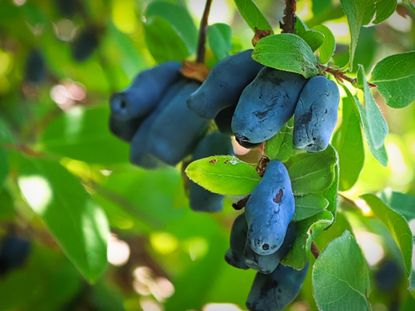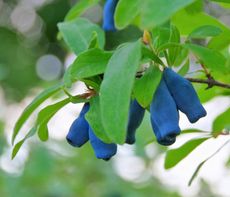Honeyberry Growing Tips: How To Grow Honeyberries In Pots


Honeyberry bushes produce a 3- to 5-foot (1 to 1.5 m.) tall shrub, which is ideal for container growing. Young plants can be purchased in 3-gallon (11.5 L.) pots and grown on for a couple of years before they need to be repotted. The keys to container grow honeyberry plants are the type of soil and the exposure. Potted honeyberries have just as good a chance as in-ground plants to produce an abundant harvest and can add rustic appeal and color to your patio, lanai, or other small spaces.
Choosing a Container for Potted Honeyberries
Honeyberries, or Haskap, are native to Russia and Japan but have naturalized widely in Canada. The sweet berries look like mutant blueberries but pack a more honeyed flavor. The plants are easy-to-care-for bushes that need good circulation, full sun, and well-drained soil. They are remarkably tolerant of alternative conditions but the best products will be achieved in optimum conditions. When you grow honeyberries in pots, you should try to accommodate the plant's preferences since it is in a closed environment. Container grown fruiting plants need excellent drainage to prevent root rot. It is also a good idea to consider using unglazed clay pots which can evaporate any excess moisture and hold heat to keep the soil warm. One of the pro honeyberry growing tips is to enhance circulation. One way to help the plant get good airflow is by setting it on a stand where natural breezes can cool the stems and leaves. Plants can easily be trimmed to fit the container size but avoid any pruning until after the plants have bloomed. It is not necessary to use a large container, initially, when you grow honeyberries in a pot. Change to a slightly larger container every 2 to 3 years or as you begin to see feeder roots at the surface of the soil.
Honeyberry Growing Tips
Honeyberry plants produce best in places where there are 6 to 8 hours of sunlight. However, the plants can thrive in less light but the harvest may be reduced. The plants can get some foliar damage in high light situations, so gardeners often construct a screen or another device to shade the plant at midday. Another option when growing honeyberries in containers is to keep it on a coaster and move the plant to shade for a few hours at noon. Honeyberry is also adapted to a wide variety of soils, but since it is captive in its container, it is best to provide a good potting soil with equal parts compost and sand mixed in. This will provide a good fertile, well-draining medium. Potted honeyberries are actually quite unfussy and should be easy to grow. The plants are even United States Department of Agriculture zone 3 hardy, so they do not need much special care in winter. Good care is part of growing honeyberries in containers. Keep plants moderately moist in spring. They can handle short periods of drought, but container bound plants need a bit of extra moisture as compared to in-ground plants. Fertilize in spring with a formula that lists blueberries, as their nutritional needs are similar. Alternatively, you can add an inch (2.5 cm.) of good compost in spring to gently release nutrients to the soil. When you container grow honeyberry plants, you may have some competition from the birds for the sweet fruit. Use some bird netting to save your harvest. Pruning isn't necessary to get fruit. Simply remove old and diseased wood, shorten and thin as necessary and keep 8 to 10 good stems rising from the crown with good circulation.
Gardening tips, videos, info and more delivered right to your inbox!
Sign up for the Gardening Know How newsletter today and receive a free download of our most popular eBook "How to Grow Delicious Tomatoes."

Bonnie Grant is a professional landscaper with a Certification in Urban Gardening. She has been gardening and writing for 15 years. A former professional chef, she has a passion for edible landscaping.
-
 How To Get Rid Of Mosquitoes In The Garden: 9 Natural Ways To Make Them Buzz Off!
How To Get Rid Of Mosquitoes In The Garden: 9 Natural Ways To Make Them Buzz Off!How to get rid of mosquitoes is on the minds of people in the summer in almost every region of the world. Learn how to repel the pests without toxic chemicals.
By Mary Ellen Ellis
-
 Monkey Orchid Care: How To Grow This Fascinating Species
Monkey Orchid Care: How To Grow This Fascinating SpeciesThe monkey orchid bears a remarkable resemblance to its namesake and, with a little know-how, can be successfully grown as a houseplant.
By Bonnie L. Grant
